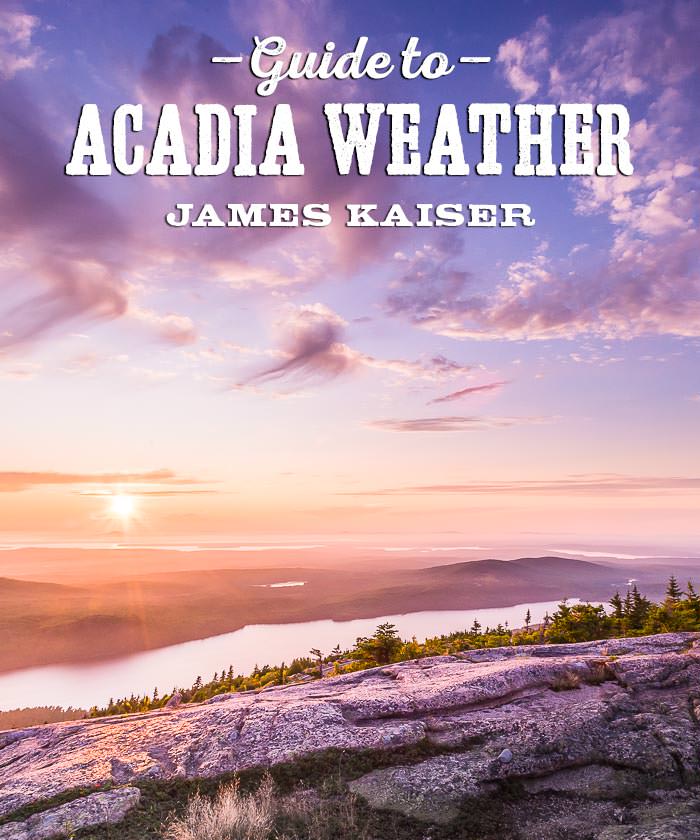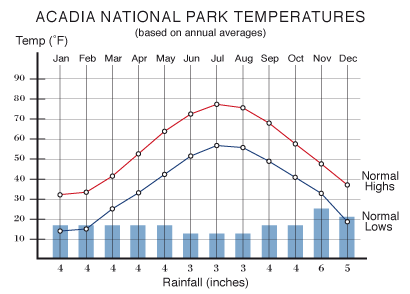
Weather in Acadia National Park is — in a word — unpredictable. Although summers on Mount Desert Island are generally sunny and divine, conditions can change in an instant. What started out as a sunny day in Bar Harbor can end in rain, fog or (in rare cases) hail.
Weather patterns in Maine — and all of New England for that matter — are more variable and extreme than almost any other place the United States. As Mark Twain once wrote, “I reverently believe that the Maker who made us all makes everything in New England but the weather. I don’t know who makes that, but I think it must be some raw apprentices in the weather-clerk’s factory.”
See also: Best Times to Visit Acadia National Park
Acadia Weather Forecasts
My favorite source of forecasts and weather info is the National Weather Service. But in my experience, even their forecasts are only partially reliable. Most are based on regional forecasts, and there’s tremendous variability within the region. In my highly non-scientific study of local forecasts, I’ve found that 24-hour reports are right about 70% of the time, 48-hour reports are right about 50% of the time, and 36-hour reports are right about 30% of the time. Any report over 36 hours is pretty much useless.

Acadia National Park is located at roughly 45º N latitude, exactly halfway between the Equator and the North Pole. This puts the park in the middle battleground between the hot, humid air of the tropics and the cold, dry air of the Arctic. Storms in these middle latitudes follow fairly predictable paths called storm tracks, and almost all storm tracks in the United States have the potential to pass through Maine.
Hurricane Season in Acadia
In addition to regular storms, Acadia National Park must also contend with hurricane season, which officially runs from June through November. Most hurricanes make landfall in the Southeast and dissipate long before reaching Maine. Those hurricanes that do make it to Maine generally arrive in August, September, or October, and most are Category 2 or less by the time they arrive.
Temperatures in Maine can vary dramatically throughout the year, but temperatures along the coast are moderated by the ocean. In June, July and August, when inland Maine is hot and humid, the Gulf of Maine’s cold water keeps Acadia’s temperatures mild. In January, February and March, when inland Maine often suffers sub-zero temperatures, the ocean’s relative warmth boosts temperatures along the coast.
North Atlantic Oscillation
Long-term weather trends in Acadia National Park are also influenced by a weather system known as the North Atlantic Oscillation (NAO). The NAO results from the interaction between a semi-permanent low pressure system over Iceland (the Icelandic Low) and a semi-permanent high pressure system over Bermuda (the Bermuda High). The interactions between these two systems have the power to alter storm tracks across the North Atlantic.
When the pressure difference between these two systems is high, the NAO is in positive mode, resulting in relatively milder temperatures and decreased storm activity in Maine. When the pressure difference between the Icelandic Low and the Bermuda High is low, the NAO is in negative mode, which often brings cold temperatures and increased storm activity to Maine. NAO modes are long-term trends that can last for decades, and the present NAO mode has been mostly positive since the late 1970s.
Reading the Wind in Acadia
Although weather conditions in Acadia National Park can change at a moment’s notice, you can still get a general sense of what lies ahead by doing what sailors have done for hundreds of years: reading the wind…
Continued in Acadia: The Complete Guide…

